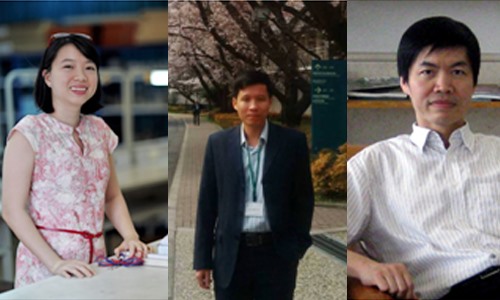Vietnamese scientists featured in elite journal
Three scientists have made Vietnamese science history as their work has been published in one of the most prestigious journals in the field of physics, Physical Review Letters, on January 9. This is considered as a paving way for more pronounced presence of Vietnamese works in the international science community.
 |
| From left to right: researcher fellow Le Thi Quynh Huong, Associate Professor Nguyen Quang Hung and Ph.D. Nguyen Dinh Dang (vnexpress.net) |
The study, entitled 'Simultaneous microscopic description of nuclear level density and radiative strength function', was conducted by two researchers working in Viet Nam, namely Associate Professor Nguyen Quang Hung, from the Institute of Research and Development, Duy Tan University, in Da Nang, and researcher fellow Le Thi Quynh Huong, from Khanh Hoa University, Nha Trang; and PhD Nguyen Dinh Dang, who is currently working at the RIKEN Nishina Centre for Accelerator-based Science in Japan.
Dang said this was his fifth work that published in the journal, but “this is the first time that all three authors of a nuclear physics study are Vietnamese citizens.”
The science news site Phys.org called the study 'a major breakthrough', saying that this was the first time a 'unified and consistent microscopic approach capable of describing simultaneously two important quantities for understanding the statistical properties of nuclei' had been devised.
Nuclear level density and radiative strength function are two important factors in nuclear research as they play a critical role in nuclear energy production and transmutation of nuclear waste, the site said.
The study was sent to Physical Review Letters last September, and it passed three rounds of reviews from leading experts in the field.
To be published, a study must advance the field, open a new area of research or help solve a critical outstanding problem, according to the journal’s acceptance criteria.
Hung said the most difficult step was writing the draft. To be accepted by the journal, which specialises in short-form papers, the article’s word count must not exceed 3,750 words, but the article must still reflect the full content of the study.
“It took us 90 days just to finish the first draft of the article,” Hung said.
In recent years, the Physical Review Letters’ acceptance rate for publication of submitted papers hovers below 25 per cent, a testament to its prestige, making the Vietnamese scientists achievement even more of an impressive feat.
(Source: VNS/ DA NANG Today)